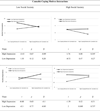Multisubstance Use Among Treatment-Seeking Smokers: Synergistic Effects of Coping Motives for Cannabis and Alcohol Use and Social Anxiety/Depressive Symptoms
- PMID: 26846421
- PMCID: PMC4755824
- DOI: 10.3109/10826084.2015.1082596
Multisubstance Use Among Treatment-Seeking Smokers: Synergistic Effects of Coping Motives for Cannabis and Alcohol Use and Social Anxiety/Depressive Symptoms
Abstract
Objective: This study examined the impact of coping motives for cannabis and alcohol use on the relation between social anxiety/depressive symptoms and severity of substance use for alcohol, tobacco, and cannabis among treatment-seeking smokers who also use cannabis and alcohol.
Methods: The sample included 197 daily cigarette smokers (MAge 34.81 years, SD = 13.43) who reported using cannabis and alcohol.
Results: Hierarchical multiple regression analyses were conducted wherein separate models were constructed for each dependent variable. Among individuals with higher social anxiety, alcohol coping motives were associated with heavier drinking, and this was more pronounced among those low in depressive symptoms. Similarly, those at greater risk for nicotine dependence were anxious individuals with lower depressive symptoms who endorse coping-oriented motives for using cannabis. Further, among those with higher social anxiety, cannabis coping motives were associated with marginally greater drinking, particularly for those high in depressive symptoms.
Conclusions: The present findings support the perspective that among multisubstance users, the interplay between social anxiety, depressive symptoms, and coping-oriented motives for using one substance (e.g., cannabis or alcohol) may pose difficulties in refraining from other substances (e.g., tobacco). This observation highlights the importance of tailoring multisubstance treatments to specific needs of multiusers for whom single-substance interventions may be less effective. Findings also support previous work exploring the benefits of concurrently treating co-occurring substance use and lend credence to the perspective that motivation to use substances for coping reasons is of central theoretical and clinical relevance.
Keywords: Coping; alcohol; cannabis; depressive symptoms; motives; social anxiety; tobacco.
Figures
Similar articles
-
[Drinking motivates, depending on the use of tobacco and cannabis among adolescents].Przegl Lek. 2014;71(11):592-6. Przegl Lek. 2014. PMID: 25799851 Polish.
-
Anxiety sensitivity components in relation to alcohol and cannabis use, motives, and problems in treatment-seeking cigarette smokers.Addict Behav. 2018 Jul;82:166-173. doi: 10.1016/j.addbeh.2018.03.008. Epub 2018 Mar 8. Addict Behav. 2018. PMID: 29544169 Free PMC article.
-
The influence of cannabis motives on alcohol, cannabis, and tobacco use among treatment-seeking cigarette smokers.Drug Alcohol Depend. 2015 Jan 1;146:81-8. doi: 10.1016/j.drugalcdep.2014.11.013. Epub 2014 Nov 26. Drug Alcohol Depend. 2015. PMID: 25481854 Free PMC article.
-
The epigenetic modulation of alcohol/ethanol and cannabis exposure/co-exposure during different stages.Open Biol. 2019 Jan 31;9(1):180115. doi: 10.1098/rsob.180115. Open Biol. 2019. PMID: 30958117 Free PMC article. Review.
-
Sport-Related and Psychosocial Factors Associated With Motives and Consequences Of Alcohol and Cannabis Use Among NCAA Athletes: A Systematic Review.Alcohol Alcohol. 2022 Jan 8;57(1):74-84. doi: 10.1093/alcalc/agab022. Alcohol Alcohol. 2022. PMID: 33842947
Cited by
-
Prevalence and determinants of cigarette-cannabis co-use among US cancer survivors.J Cancer Surviv. 2025 Mar 29. doi: 10.1007/s11764-025-01789-2. Online ahead of print. J Cancer Surviv. 2025. PMID: 40156654
-
Anxiety sensitivity and cigarette use on cannabis use problems, perceived barriers for cannabis cessation, and self-efficacy for quitting among adults with cannabis use disorder.Addict Behav. 2023 Feb;137:107509. doi: 10.1016/j.addbeh.2022.107509. Epub 2022 Oct 1. Addict Behav. 2023. PMID: 36194977 Free PMC article.
-
The Relationship Between Social Anxiety and Alcohol and Marijuana Use Outcomes Among Concurrent Users: A Motivational Model of Substance Use.Alcohol Clin Exp Res. 2019 Apr;43(4):732-740. doi: 10.1111/acer.13966. Epub 2019 Mar 4. Alcohol Clin Exp Res. 2019. PMID: 30830692 Free PMC article.
-
A Decade of Gabapentinoid Misuse: An Analysis of the European Medicines Agency's 'Suspected Adverse Drug Reactions' Database.CNS Drugs. 2016 Jul;30(7):647-54. doi: 10.1007/s40263-016-0359-y. CNS Drugs. 2016. PMID: 27312320
-
Cannabis use among cancer survivors before and during the COVID-19 pandemic, 2019-2021.JNCI Cancer Spectr. 2023 May 2;7(3):pkad031. doi: 10.1093/jncics/pkad031. JNCI Cancer Spectr. 2023. PMID: 37079754 Free PMC article.
References
-
- Aiken LS, West SG. Multiple regression: Testing and interpreting interactions. Thousand Oaks, California: SAGE Publications, Inc; 1991.
-
- B FM, W WJB, Spitzer RL, Gibbon M. Structured Clinical Interview for DSM-IV-TR Axis I Disorders, Clinical Trials Version (SCID-CT) New York: Biometrics Research, New York State Psychiatric Institute; 2007.
-
- Baker TB, Piper ME, McCarthy DE, Majeskie MR, Fiore MC. Addiction motivation reformulated: an affective processing model of negative reinforcement. Psychol Rev. 2004;111(1):33–51. - PubMed
-
- Bonn-Miller MO, Zvolensky MJ. An evaluation of the nature of marijuana use and its motives among young adult active users. Am J Addict. 2009;18(5):409–416. - PubMed
Publication types
MeSH terms
Grants and funding
LinkOut - more resources
Full Text Sources
Other Literature Sources
Medical


